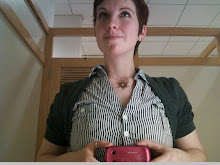Thursday, March 31, 2011
Inclusive Leadership (Engagement Requirement)
Posted by Starr B at 6:26 PM 0 comments
Friday, March 18, 2011
Weekly Activism Log for Service Learning-Week 3
Posted by Starr B at 1:02 PM 1 comments
Pink Art II (Engagement Requirement)
Posted by Starr B at 12:31 PM 0 comments
Tuesday, March 15, 2011
"After years of analysing what makes leaders effective, management gurus have figured out how to boost the odds of hiring a great executive: Hire a female"
-Sharpe, 2002, in BusinessWeek
Posted by Starr B at 7:27 PM 0 comments
Friday, March 4, 2011
Weekly Activism Log for Service Learning- Week 2
1. Activism
This week consisted of three different service learning events.
Saturday I attended part of a Young Women Leaders Program research day-incorporating both time for the younger girls to interact one-on-one with their respective older mentors, and many group activities.
On Wednesday I helped to orchestrate and carry out the planned "What's In Your Wallet" UCF Leadership week seminar. This event was held by our community partner and professor Meredith Tweed. Not only did each involved member get to actively lead a certain part of the seminar, but there was a great group of interested students who attended and deeply discussed the topic of privilege and how it interacts with leading.
Later in the day I volunteered with the LEAD Scholars department at UCF to help facilitate a seminar called "Become a super hero through research." The seminar brought forth a handful of undergraduate freshmen and sophomore students who were interested in finding a mentor and leading through researching topics in their major. The instructor (Doctor Schneider of the Undergraduate Research Office at UCF) was helpful in sharing information with students about how to begin their research, and what events happened to encourage their garnering of support, and how to plan ahead for grants and timing.
2. Reflection
While attending the Young Women Leaders Program event and observing the women in attendance I realized that each big was respectful and assumed mature attitudes from their littles- therefore enabling the younger women to act as they see fit-encouraging their growth and learning process throughout the day's activities. When a research student would lead the entire group they would in different styles-some slightly more agentic, some communal. I got to see how having strong women mentors can be very important for women of the next generation to see and grow accustomed to-blazing a trail to make the labyrinth a little bit easier to navigate.
With the “What’s In Your Wallet” seminar, I was not only able to analyze more of my own leading style (I tended to want to be kinder, more stereotypically “feminine” with the group of attendees)—I also was able to analyze all types of students who chose to attend this seminar and discuss issues involving race, sex, and gender-and ingrained and given privileges- and then linking those topics to leadership.
Posted by Starr B at 8:57 PM 0 comments
